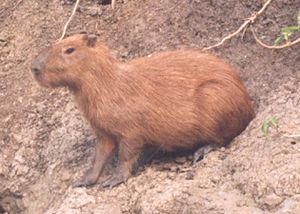- v50 information can now be added to pages in the main namespace. v0.47 information can still be found in the DF2014 namespace. See here for more details on the new versioning policy.
- Use this page to report any issues related to the migration.
Capybara
|
c
| |
| Urist likes capybaras for their graceful swimming. | |
|---|---|
| Biome | |
|
| |
| Variations | |
| Attributes | |
| Tamed Attributes | |
| Pet value | 100 |
|
| |
|
Not hunting/war trainable | |
| Size | |
| Birth: | 4,500 cm3 |
| Mid: | 22,500 cm3 |
| Max: | 45,000 cm3
|
| Age | |
| Adult at: | 1 |
| Max age: | 10-12 |
| Butchering returns
(Value multiplier ×2) | |
|
Food items | |
| Meat | 11 |
| Fat | 11 |
| Brain | 1 |
| Heart | 1 |
| Lungs | 2 |
| Intestines | 1 |
| Liver | 1 |
| Kidneys | 2 |
| Tripe | 1 |
| Sweetbread | 1 |
| Spleen | 1 |
|
Raw materials | |
| Bones | 11 |
| Skull | 1 |
| Skin | Raw hide |
v50.12 · v0.47.05 This article is about the current version of DF.Note that some content may still need to be updated. |
- A medium-sized semi-aquatic rodent. It lives in large herds and barks when alarmed.
The Capybara and its derivatives are among the very few animals in the game which you can hear at a distance in Adventure mode. The only other species known to issue sounds is the kakapo. Capybara sounds will be described as whistling or barking. The possible announcements are as follows:
- "You hear whistling."
- "You hear deep whistling."
- "You hear barking."
If tamed in Fortress Mode, capybaras require a pasture. They are amphibious, being able to swim even from birth. They make moderate-value pets, and produce respectable butchering returns, though other non-grazing species require less space and management.
Some dwarves admire capybaras for their enormous rodentness, their graceful swimming, or their resonant barking.
The capybara is the largest extant rodent in the world; they are close relatives of guinea pigs. However, in DF, as they are 3/4 the size of an adult dwarf, they can easily kill if provoked.
Native to in South America in real life, a normal capybara litter is 4 pups according to Wikipedia; in Dwarf Fortress, however, they only give birth to 1-3 at a time.
Capybaras were sponsored by the generous contributions of the Bay 12 community.
Speak!
DrVoke
happybara
Izzy
Rokoko
Cameo
[CREATURE:CAPYBARA]
[DESCRIPTION:A medium-sized semi-aquatic rodent. It lives in large herds and barks when alarmed.]
[NAME:capybara:capybaras:capybara]
[CASTE_NAME:capybara:capybaras:capybara]
[CHILD:1][GENERAL_CHILD_NAME:capybara pup:capybara pups]
[CREATURE_TILE:'c'][COLOR:6:0:0]
[CREATURE_CLASS:MAMMAL]
[PETVALUE:100]
[PET]
[NATURAL]
[STANDARD_GRAZER]
[AMPHIBIOUS]
[LARGE_ROAMING]
[POPULATION_NUMBER:20:30]
[CLUSTER_NUMBER:5:10]
[BIOME:ANY_WETLAND]
[GRASSTRAMPLE:0]
[MEANDERER]
[VISION_ARC:50:310]
[SOUND:ALERT:100:1000:VOCALIZATION:bark:barks:a loud bark]
[SOUND:PEACEFUL_INTERMITTENT:100:10000:VOCALIZATION:whistle:whistles:whistling]
[SOUND:PEACEFUL_INTERMITTENT:25:10000:VOCALIZATION:grunt:grunts:a grunt]
[SOUND:PEACEFUL_INTERMITTENT:5:10000:VOCALIZATION:purr:purrs:a purr]
[SOUND:PEACEFUL_INTERMITTENT:25:10000:NONE:click:clicks:a click]
[PREFSTRING:enormous rodentness]
[PREFSTRING:graceful swimming]
[PREFSTRING:resonant barking]
[BODY:QUADRUPED_NECK:2EYES:2EARS:NOSE:2LUNGS:HEART:GUTS:ORGANS:THROAT:NECK:SPINE:BRAIN:SKULL:4TOES_FQ_REG:3TOES_RQ_REG:MOUTH:TONGUE:RODENT_TEETH:RIBCAGE]
[BODYGLOSS:PAW]
[BODY_DETAIL_PLAN:STANDARD_MATERIALS]
[BODY_DETAIL_PLAN:STANDARD_TISSUES]
[BODY_DETAIL_PLAN:VERTEBRATE_TISSUE_LAYERS:SKIN:FAT:MUSCLE:BONE:CARTILAGE]
[BODY_DETAIL_PLAN:BODY_HAIR_TISSUE_LAYERS:HAIR]
[USE_MATERIAL_TEMPLATE:NAIL:NAIL_TEMPLATE]
[USE_TISSUE_TEMPLATE:NAIL:NAIL_TEMPLATE]
[TISSUE_LAYER:BY_CATEGORY:TOE:NAIL:FRONT]
[SELECT_TISSUE_LAYER:HEART:BY_CATEGORY:HEART]
[PLUS_TISSUE_LAYER:SKIN:BY_CATEGORY:THROAT]
[TL_MAJOR_ARTERIES]
[BODY_DETAIL_PLAN:STANDARD_HEAD_POSITIONS]
[BODY_DETAIL_PLAN:HUMANOID_RIBCAGE_POSITIONS]
[USE_MATERIAL_TEMPLATE:SINEW:SINEW_TEMPLATE]
[TENDONS:LOCAL_CREATURE_MAT:SINEW:200]
[LIGAMENTS:LOCAL_CREATURE_MAT:SINEW:200]
[HAS_NERVES]
[USE_MATERIAL_TEMPLATE:BLOOD:BLOOD_TEMPLATE]
[BLOOD:LOCAL_CREATURE_MAT:BLOOD:LIQUID]
[CREATURE_CLASS:GENERAL_POISON]
[GETS_WOUND_INFECTIONS]
[GETS_INFECTIONS_FROM_ROT]
[USE_MATERIAL_TEMPLATE:PUS:PUS_TEMPLATE]
[PUS:LOCAL_CREATURE_MAT:PUS:LIQUID]
[BODY_SIZE:0:0:4500]
[BODY_SIZE:1:0:22500]
[BODY_SIZE:2:0:45000]
[BODY_APPEARANCE_MODIFIER:LENGTH:90:95:98:100:102:105:110]
[BODY_APPEARANCE_MODIFIER:HEIGHT:90:95:98:100:102:105:110]
[BODY_APPEARANCE_MODIFIER:BROADNESS:90:95:98:100:102:105:110]
[MAXAGE:10:12]
[ATTACK:BITE:CHILD_BODYPART_GROUP:BY_CATEGORY:HEAD:BY_CATEGORY:TOOTH]
[ATTACK_SKILL:BITE]
[ATTACK_VERB:bite:bites]
[ATTACK_CONTACT_PERC:100]
[ATTACK_PENETRATION_PERC:100]
[ATTACK_FLAG_EDGE]
[ATTACK_PREPARE_AND_RECOVER:3:3]
[ATTACK_PRIORITY:MAIN]
[ATTACK_FLAG_CANLATCH]
[ATTACK:SCRATCH:CHILD_TISSUE_LAYER_GROUP:BY_TYPE:STANCE:BY_CATEGORY:ALL:NAIL]
[ATTACK_SKILL:GRASP_STRIKE]
[ATTACK_VERB:scratch:scratches]
[ATTACK_CONTACT_PERC:100]
[ATTACK_PENETRATION_PERC:100]
[ATTACK_FLAG_EDGE]
[ATTACK_PREPARE_AND_RECOVER:3:3]
[ATTACK_PRIORITY:SECOND]
[DIURNAL]
[HOMEOTHERM:10067]
[APPLY_CREATURE_VARIATION:STANDARD_QUADRUPED_GAITS:900:734:568:366:1900:2900] 24 kph
[APPLY_CREATURE_VARIATION:STANDARD_SWIMMING_GAITS:6561:6115:5683:1755:7456:8567] 5 kph, NO DATA
[APPLY_CREATURE_VARIATION:STANDARD_CRAWLING_GAITS:6561:6115:5683:1755:7456:8567] 5 kph
[SWIMS_INNATE]
[MUNDANE]
[CASTE:FEMALE]
[FEMALE]
[CASTE:MALE]
[MALE]
[SET_BP_GROUP:BY_TYPE:LOWERBODY][BP_ADD_TYPE:GELDABLE]
[SELECT_CASTE:ALL]
[SET_TL_GROUP:BY_CATEGORY:ALL:HAIR]
[TL_COLOR_MODIFIER:LIGHT_BROWN:1]
[TLCM_NOUN:hair:SINGULAR]
[SET_TL_GROUP:BY_CATEGORY:ALL:SKIN]
[TL_COLOR_MODIFIER:DARK_PINK:1] need more info
[TLCM_NOUN:skin:SINGULAR]
[SET_TL_GROUP:BY_CATEGORY:EYE:EYE]
[TL_COLOR_MODIFIER:IRIS_EYE_DARK_BROWN:1]
[TLCM_NOUN:eyes:PLURAL]
[SELECT_MATERIAL:ALL]
[MULTIPLY_VALUE:2] |
